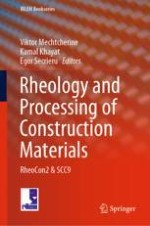2020 | OriginalPaper | Chapter
Novel Mix Design Methodology for Self-Compacting Steel-Fiber Reinforced Concrete Based on Rheological and Mechanical Concepts
Authors : Ángel de la Rosa, Elisa Poveda, Gonzalo Ruiz, Héctor Cifuentes
Published in: Rheology and Processing of Construction Materials
Publisher: Springer International Publishing
Activate our intelligent search to find suitable subject content or patents.
Select sections of text to find matching patents with Artificial Intelligence. powered by
Select sections of text to find additional relevant content using AI-assisted search. powered by
